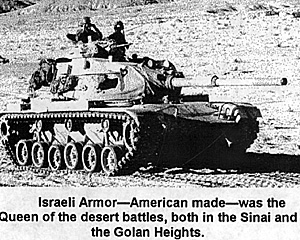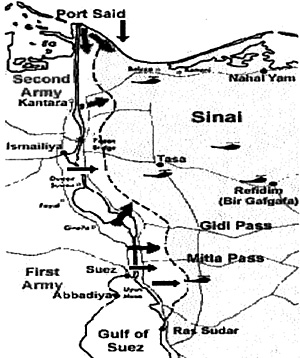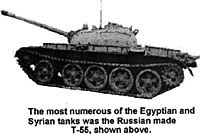 On the Jewish High Holy Day of Yom Kippur,
October 6, 1973, the combined forces of Egypt and Syria,
with assistance from Jordan, Iraq, and several other Arab
states, made a surprise attack against Israel. They came
very close to succeeding.
On the Jewish High Holy Day of Yom Kippur,
October 6, 1973, the combined forces of Egypt and Syria,
with assistance from Jordan, Iraq, and several other Arab
states, made a surprise attack against Israel. They came
very close to succeeding.
The Egyptians knew they could not match the Israelis in a war of maneuver, so they fought a very different sort of war. On the Israeli side of the Suez Canal, a single brigade held the Bar Lev Line. It was thinly stretched over the entire length of the Suez Canal in a series of strong points. The Egyptians attacked it with 6 infantry divisions, supported by 3 armored divisions. To counter the ferocity of the Israeli air force, the Egyptians had built up their own air force, and also deployed numerous Soviet-supplied SAM missile batteries. Combining high-altitude and low-altitude SAMS, the Egyptians fought beneath a protective umbrella they had never had before.
 In the initial assault 240 Egyptian aircraft
attacked Israeli airfields in the Sinai. An artillery barrage
from 2,000 pieces of artillery pounded the Bar Lev Line.
This, with direct fire from the Egyptian side of the canal
kept the Israeli defenders pinned down. During the
barrage, helicopters landed commandos to take out the
defensive positions, while 8,000 men were ferried across
on rubber rafts. These men bypassed the Israeli
defensive positions and moved inland, anywhere from
three to six miles with hand-held anti-tank and anti-aircraft
missiles.
In the initial assault 240 Egyptian aircraft
attacked Israeli airfields in the Sinai. An artillery barrage
from 2,000 pieces of artillery pounded the Bar Lev Line.
This, with direct fire from the Egyptian side of the canal
kept the Israeli defenders pinned down. During the
barrage, helicopters landed commandos to take out the
defensive positions, while 8,000 men were ferried across
on rubber rafts. These men bypassed the Israeli
defensive positions and moved inland, anywhere from
three to six miles with hand-held anti-tank and anti-aircraft
missiles.
Here the Egyptians planned to await the inevitable Israeli counter attack. They had artillery and air support, and dug themselves in beneath the SAM umbrella of high and low altitude anti aircraft missiles. Meanwhile, they worked on reducing the Israeli forts along the Suez Canal.
By October 10, all of the Israeli reserves had been mobilized, and the front in the Sinai had stabilized. The Israelis were now waiting for the Egyptians to bring the bulk of their armor over to their side of the canal before launching Operation Gazelle, which was to be a cross canal attack.
The Syrians, in an effort to relieve some of the pressure on their front on the Golan Heights, requested the Egyptians to attack. The Egyptians responded by bringing over 1,500 tanks across the canal, and launching a series of multi-brigade and division-sized assaults. Moving beyond the protective umbrella the SAMs provided, the Egyptian assaults all failed, and cost them 200 tanks.
 It seems that three years before the outbreak of
the Yom Kippur War, General Sharon had prepared a
crossing site on the Suez Canal for an invasion of Egypt
near the Bitter Lakes. Equally, it so happened that this
site was at the juncture of the two Egyptian Armies--traditionally the weakest link in the chain. Sharon
launched his division toward the crossing site, moving
along the juncture of the two armies. After some hard
fighting, the Israelis reached the Suez Canal and began
to ferry troops across. Now attacked from both north
and south, the Israeli line held, and the west
bank of the Suez Canal kept receiving reinforcements.
It seems that three years before the outbreak of
the Yom Kippur War, General Sharon had prepared a
crossing site on the Suez Canal for an invasion of Egypt
near the Bitter Lakes. Equally, it so happened that this
site was at the juncture of the two Egyptian Armies--traditionally the weakest link in the chain. Sharon
launched his division toward the crossing site, moving
along the juncture of the two armies. After some hard
fighting, the Israelis reached the Suez Canal and began
to ferry troops across. Now attacked from both north
and south, the Israeli line held, and the west
bank of the Suez Canal kept receiving reinforcements.
The Israeli ground troops on the west bank began taking out the SAM anti-aircraft sites, and airfields, thus creating a huge hole in the Egyptian's anti-aircraft umbrella. The Israelis succeeded in cutting off the entire Egyptian Army in the south, and threatening the same to the army in the north. At this point the Egyptians asked their Russian Allies in the Security Council to demand a ceasefire, because they had failed.
 Meanwhile, on the Syrian Front, the Syrian Army had
nearly broken through. Along the 30 miles of the Golan
Heights Front, the Israelis had constructed 17
fortifications for platoon-sized units. They were designed
not to stop an attack but to get the Syrians to deploy and
bog down. Supporting this trip-wire defense were two
armored brigades (170 tanks) and 10 artillery batteries.
Meanwhile, on the Syrian Front, the Syrian Army had
nearly broken through. Along the 30 miles of the Golan
Heights Front, the Israelis had constructed 17
fortifications for platoon-sized units. They were designed
not to stop an attack but to get the Syrians to deploy and
bog down. Supporting this trip-wire defense were two
armored brigades (170 tanks) and 10 artillery batteries.
The Syrians bombarded the defenders using 1,100 guns and their air force, before launching a force that included 1,500 tanks at the Golan Heights. The Syrians very nearly broke through, but individual tanks and infantry platoons were fed into each hole as they came up to the Heights upon mobilization by Major General Dan Laner, who supervised their deployment. The Syrians were held Every single Israeli tank on the line had been hit, but the Syrians had lost 800 tanks in the Golan Heights.
Finally, the Israelis went over onto the offensive. By October 11, the Israeli's were attacking toward Sasa. At this point the Syrians began to receive reinforcements from Iraq, Jordan, and other Arab states. The Syrian Front stabilized.
The Arab states had lost in their bid to defeat Israel, but they had proven to be tough opponents, who had come uncomfortably close to success.
The thing about a war that's close is that it makes an interesting wargame. When I still lived in New York, my neighbor and wargame buddy, Mitch Freedman, and I discovered a little game entitled The Yom Kippur War. It was as evenly balanced as the war, with initial Arab strength crushing Israeli weakness. Of course, Israeli reinforcements--as the nation mobilized--eventually balanced the picture. And yes, the SAMs really did a lot to fend off the Israeli air attacks. Either that, or use micro- armor to fight out an interesting war.
Back to Novag's Gamer's Closet Summer 2002 Table of Contents
Back to Novag's Gamer's Closet List of Issues
Back to MagWeb Master Magazine List
© Copyright 2002 by Novag
This article appears in MagWeb.com (Magazine Web) on the Internet World Wide Web. Other articles from military history and related magazines are available at http://www.magweb.com